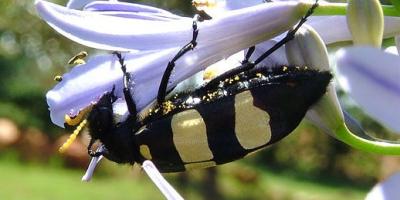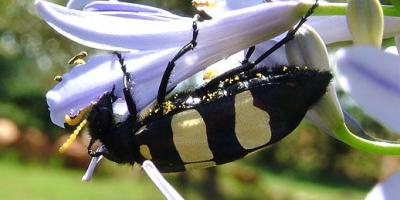

Flower beetles (<i>Mylabris</i> spp. and <i>Coryna</i> spp.)
Flower beetles are also known as pollen beetles or blister beetles. Adult beetles feed on flowers reducing pod set. They also feed on foliage biting off irregular patches on leaves. Larvae of these beetles do not feed on plants but on eggs of grasshoppers and locusts. Therefore, they are beneficial and should not be destroyed.
The beetles lay eggs in the soil. Upon hatching, young larvae are very active and mobile searching for eggs of grasshoppers and locusts. The larvae then burrow underground and start feeding on the eggs. Older larvae become sluggish and change shape turning fat, and getting a large body and reduced legs. These beetles are difficult to control because of their mobility. The damage caused is usually not of economic importance.
- Monitor crop regularly.
- Hand pick adults regularly. This helps to maintain their numbers low in small plots. . However, do not destroy all of them, but keep numbers in check. Care should be taken when handling these beetles, since when disturbed they release a liquid that could burn the skin. To avoid this, wear thick gloves to protect your hands.
- Provide alternative habitats by keeping flowering plants at the borders of the field.
- Spray repellents such as extracts of strong smelling plants ( eucalyptus, lantana, onion, garlic etc.). Recommended mixes vary from 20 to100 g dried aromatic leaves per litre of water. Dried leaves are immersed in boiling water and left to steep till the tea is cold. Then sieved and sprayed onto affected plants. Repellents are reported to keep most beetles away (Elwell and Maas, 1995).
